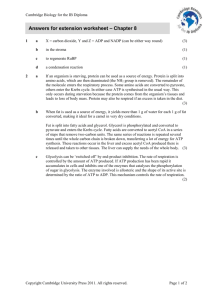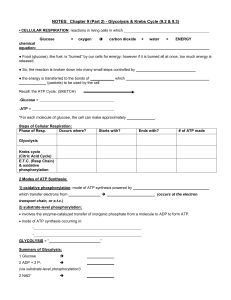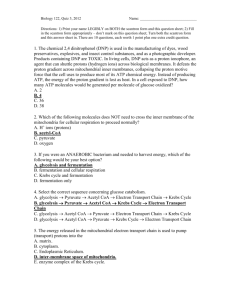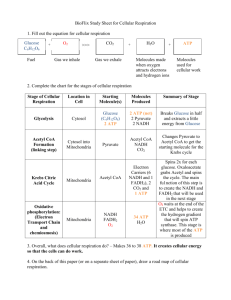File - Biology with Radjewski
advertisement
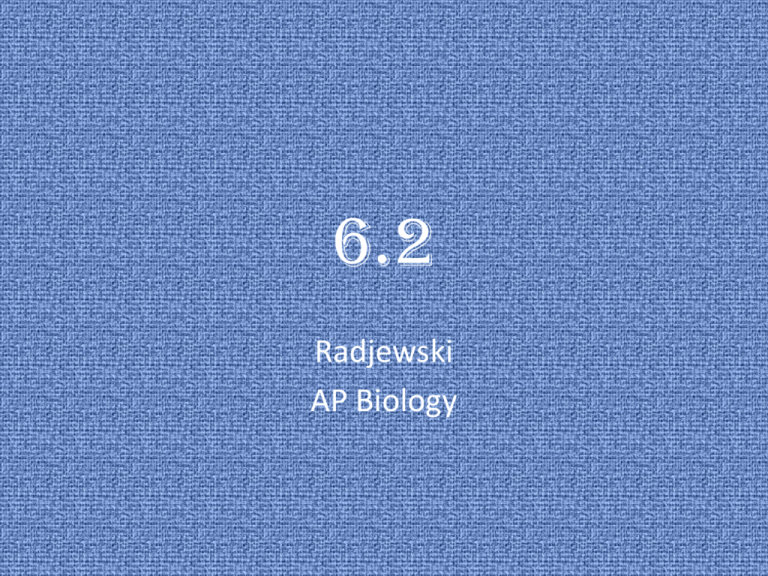
6.2 Radjewski AP Biology Cellular Respiration • Catabolism (break down) of organic molecules within cells • Key ways cells get energy • 4 steps 1. 2. 3. 4. Glycolysis Formation of Acetyl CoA (pyruvate oxidation) Krebs Cycle (Acetyl CoA oxidation) Electron Transport/Chemiosmosis • Occurs in a bunch of small steps to allow for more energy to be made Glycolysis • Takes place in the cytosol in the cytoplasm – All organisms have cytoplasm, so all organisms can do glycolysis • 10 steps • Glucose is oxidized releasing stored energy – To break down glucose, cells need to invest 2 ATP’s (endergonic) ATP is required because glucose has covalent bonds, which are strong. The phosphate from the ATP’s are basically being added to glucose in these steps. The 6 carbon molecule is broken in half, creating two 3C sugars. Later steps are exergonic and release energy, forming ATP and NADH. ATP is made through substrate level phosphorylation Glycolysis Ins/Outs • Requirements: 1 glucose, 2 ATP, 2 NAD+,4 ADP, 4 Pi • Products: 2 Pyruvates, 4 ATP,2 NADH, 2 ADP, 2 Pi • Net ATP Production is 2ATP • In the presence of oxygen, further oxidation can occur. Formation of Acetyl CoA (Pyruvate Oxidation) • Takes place in the mitochondria matrix • Pyruvate gets oxidized to a 2C acetate molecule and CO2 • Then Acetate is bound to Coenzyme A (CoA), forming acetyl coenzyme A or Acetyl CoA » It is a carrier of acetyl groups » Vitamin B • Exergonic reaction (released NADH) and decarboxylation occurred (release of CO2) Formation of Acetyl CoA (Pyruvate Oxidation) • Requirements: pyruvate, NAD+, Coenzyme A • Products: Acetyl CoA, NADH, CO2 • The main role of Acetyl CoA is to donate its acetyl group to the 4C compound oxaloacetate, forming a 6C compound, citrate Krebs Cycle • Citric Acid Cycle • 8 steps • 2C Acetyl CoA combines with 4C oxaloacetate to form 6C citrate • Citrate changes to its isomer isocitrate in step 2 (water was added and released) • In step 3, isocitrate undergoes decarboxylation to form 5C alpha-ketoglutarate. – This releases CO2 and forms NADH Krebs Cycle • In step 4, alpha ketoglutarate undergoes decarboxylation to form 4C succinyl CoA – NADH is formed and CO2 is released • In step 5, succinyl CoA loses it’s CoA to form succinate – This is a coupled reaction where GDP + Pi forms GTP, which then transfer its high energy phosphate to form ATP Krebs Cycle • In step 6, succinate undergoes dehydrogenation to form fumarate – This forms FADH2, which is similar to NADH • In step 7, fumarate adds water forming malate • In step 8, malate undergoes dehydrogenation forming oxaloacetic acid (which started the cycle!) – NADH was made! Krebs Cycle • Requirements: Acetyl CoA, 3 NAD+, 1 GDP, 1Pi, FAD, Water, CoA, Oxaloacetate • Products: 3 NADH, Water, 2 CO2, 1 ATP, FADH2 • So far, we only made 3 ATP (2 from glycolysis, and 1 from Krebs) This isn’t a lot. How do we make all the energy? Electron Transport Chain • Occurs on the cristae of the mitochondria • NADH and FADH2 are oxidized and it is exergonic – The protons get pumped through proton channels on the cristae and go through chemiosmosis • Remember this creates a proton gradient and then they go back through ATP synthase, driving the reaction to create ATP from ADP and Pi – The electrons pass through proteins and then add to oxygen (with protons) Oxidative Phosphorylation • Requirements: NADH, FADH2, Oxygen • Products: Yields a lot of ATP and H20 • For each NADH or FADH2, 2-3 ATP molecules are formed
